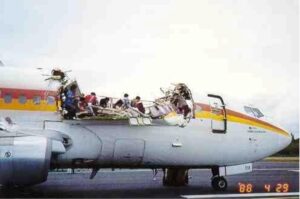
Boeing 737-200 Aloha Flight 243 showing significant structural failure.
Image source: ResearchGate (http://tinyurl.com/mrys9sna)
How long do airliners typically last? Are they ever declared ‘too old’?
Commercial airliners typically have a lifespan ranging from 20 to 30 years. In reality, a plane’s age isn’t measured in years but rather in pressurization cycles.
The pressurization process, essential for maintaining a comfortable cabin environment, inadvertently subjects the aircraft to stress, resulting in metal fatigue over time.
An aging Boeing 747, for instance, can endure approximately 35,000 pressurization cycles or accumulate 135,000 to 165,000 flight hours before metal fatigue becomes a concern. If you bend a paperclip over and over again until it snaps, you’ll understand the risks of metal fatigue
In modern planes using composite materials, this problem is not observed as yet, mitigating the risks associated with metal fatigue.
Tragically, an accident linked to metal fatigue happened in 1988 when an Aloha Airlines Boeing 737, which exceeded more than twice the safety limit with over 90,000 flight cycles, suffered an explosive decompression. Widespread metal fatigue cracks led to a portion of the aircraft’s roof tearing off during a flight between Hilo and Honolulu, resulting in one fatality – a flight attendant who was sucked off from the cabin.
The operational age of an aircraft varies based on its type and usage. A long-range Boeing 787, making one 12-hour flight daily, is likely to remain in service for more years than a short-haul Boeing 737 operating eight 2 to 3-hour flights daily.
Once a plane reaches an average age of 30 years and is declared ‘too old,’ it is often retired to aircraft boneyards in the deserts or sent to scrapyards where it is disassembled for second-hand parts.
Airlines sometimes showcase the average age of their fleet as a way of promoting their services. In the 2023 world survey, Indigo Airlines of India ranks the youngest fleet with an average age of 3.57 years. In contrast, Qantas, recognized as the world’s safest airline, maintains an average fleet age approximately four times higher at 14.7 years.
Additional examples include Singapore Airlines at 7.2 years, Malaysia Airlines at 10.82 years, and British Airways at 14.0 years. As such, fleet age alone does not necessarily reflect an airline’s safety.
Contrary to a common misconception, the age of an aircraft does not necessarily imply the plane is less reliable. The key factor lies in the airline’s commitment to good maintenance practices.
For instance, as of September 2023, United Airlines, boasting the oldest fleet among major US airlines with an average age of 16.2 years, continues to operate Boeing 767s that are between 30 and 32 years old, showcasing that with proper maintenance, older planes can still be operated safely and reliably.
View a YouTube video: Miracle Landing On Board Flight 243